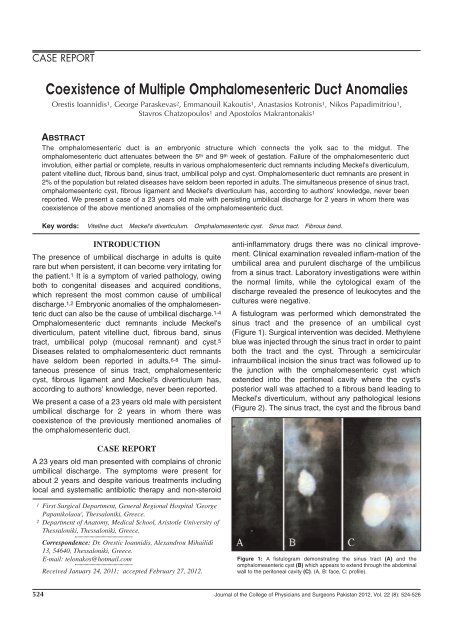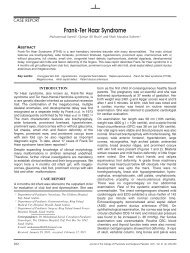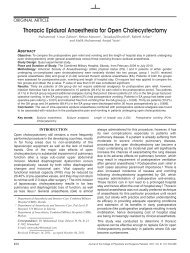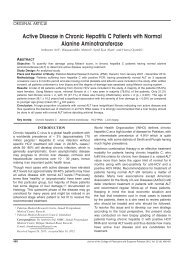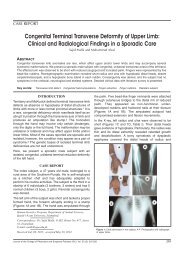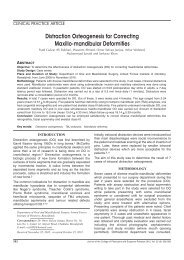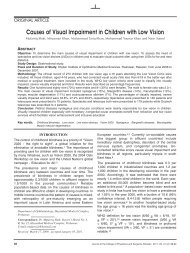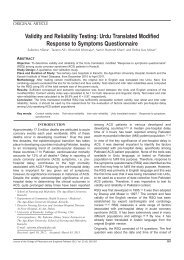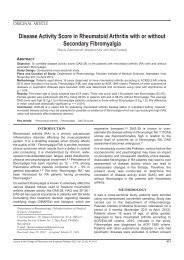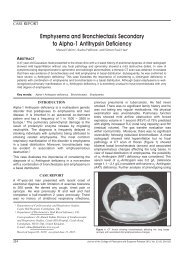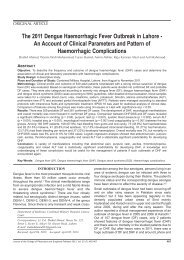Coexistence of Multiple Omphalomesenteric Duct Anomalies
Coexistence of Multiple Omphalomesenteric Duct Anomalies
Coexistence of Multiple Omphalomesenteric Duct Anomalies
- No tags were found...
You also want an ePaper? Increase the reach of your titles
YUMPU automatically turns print PDFs into web optimized ePapers that Google loves.
CASE REPORT<strong>Coexistence</strong> <strong>of</strong> <strong>Multiple</strong> <strong>Omphalomesenteric</strong> <strong>Duct</strong> <strong>Anomalies</strong>Orestis Ioannidis 1 , George Paraskevas 2 , Emmanouil Kakoutis 1 , Anastasios Kotronis 1 , Nikos Papadimitriou 1 ,Stavros Chatzopoulos 1 and Apostolos Makrantonakis 1ABSTRACTThe omphalomesenteric duct is an embryonic structure which connects the yolk sac to the midgut. Theomphalomesenteric duct attenuates between the 5 th and 9 th week <strong>of</strong> gestation. Failure <strong>of</strong> the omphalomesenteric ductinvolution, either partial or complete, results in various omphalomesenteric duct remnants including Meckel's diverticulum,patent vitelline duct, fibrous band, sinus tract, umbilical polyp and cyst. <strong>Omphalomesenteric</strong> duct remnants are present in2% <strong>of</strong> the population but related diseases have seldom been reported in adults. The simultaneous presence <strong>of</strong> sinus tract,omphalomesenteric cyst, fibrous ligament and Meckel's diverticulum has, according to authors' knowledge, never beenreported. We present a case <strong>of</strong> a 23 years old male with persisting umbilical discharge for 2 years in whom there wascoexistence <strong>of</strong> the above mentioned anomalies <strong>of</strong> the omphalomesenteric duct.Key words:Vitelline duct. Meckel's diverticulum. <strong>Omphalomesenteric</strong> cyst. Sinus tract. Fibrous band.INTRODUCTIONThe presence <strong>of</strong> umbilical discharge in adults is quiterare but when persistent, it can become very irritating forthe patient. 1 It is a symptom <strong>of</strong> varied pathology, owingboth to congenital diseases and acquired conditions,which represent the most common cause <strong>of</strong> umbilicaldischarge. 1,2 Embryonic anomalies <strong>of</strong> the omphalomesentericduct can also be the cause <strong>of</strong> umbilical discharge. 1-4<strong>Omphalomesenteric</strong> duct remnants include Meckel'sdiverticulum, patent vitelline duct, fibrous band, sinustract, umbilical polyp (mucosal remnant) and cyst. 5Diseases related to omphalomesenteric duct remnantshave seldom been reported in adults. 6-8 The simultaneouspresence <strong>of</strong> sinus tract, omphalomesentericcyst, fibrous ligament and Meckel's diverticulum has,according to authors' knowledge, never been reported.We present a case <strong>of</strong> a 23 years old male with persistentumbilical discharge for 2 years in whom there wascoexistence <strong>of</strong> the previously mentioned anomalies <strong>of</strong>the omphalomesenteric duct.anti-inflammatory drugs there was no clinical improvement.Clinical examination revealed inflam-mation <strong>of</strong> theumbilical area and purulent discharge <strong>of</strong> the umbilicusfrom a sinus tract. Laboratory investigations were withinthe normal limits, while the cytological exam <strong>of</strong> thedischarge revealed the presence <strong>of</strong> leukocytes and thecultures were negative.A fistulogram was performed which demonstrated thesinus tract and the presence <strong>of</strong> an umbilical cyst(Figure 1). Surgical intervention was decided. Methyleneblue was injected through the sinus tract in order to paintboth the tract and the cyst. Through a semicircularinfraumbilical incision the sinus tract was followed up tothe junction with the omphalomesenteric cyst whichextended into the peritoneal cavity where the cyst'sposterior wall was attached to a fibrous band leading toMeckel's diverticulum, without any pathological lesions(Figure 2). The sinus tract, the cyst and the fibrous bandCASE REPORTA 23 years old man presented with complains <strong>of</strong> chronicumbilical discharge. The symptoms were present forabout 2 years and despite various treatments includinglocal and systematic antibiotic therapy and non-steroid1 First Surgical Department, General Regional Hospital 'GeorgePapanikolaou', Thessaloniki, Greece.2 Department <strong>of</strong> Anatomy, Medical School, Aristotle University <strong>of</strong>Thessaloniki, Thessaloniki, Greece.Correspondence: Dr. Orestic Ioannidis, Alexandrou Mihailidi13, 54640, Thessaloniki, Greece.E-mail: telonakos@hotmail.comReceived January 24, 2011; accepted February 27, 2012.Figure 1: A fistulogram demonstrating the sinus tract (A) and theomphalomesenteric cyst (B) which appears to extend through the abdominalwall to the peritoneal cavity (C). (A, B: face, C: pr<strong>of</strong>ile).524 Journal <strong>of</strong> the College <strong>of</strong> Physicians and Surgeons Pakistan 2012, Vol. 22 (8): 524-526
<strong>Omphalomesenteric</strong> duct anomaliesFigure 2 Through a semicircular infraumbilical incision (A), the sinus tractwas prepared (setons) leading to the omphalomesenteric cyst (B). Theposterior wall <strong>of</strong> the omphalomesenteric cyst was attached to a fibrous band(setons) (C). This band (forceps) (D) extended to the Meckel's Diverticulum(D,E) connecting the cyst to the diverticulum. Distinct blood supply <strong>of</strong> theMeckel's diverticulum was also observed (D).were resected while the Meckel's diverticulum wasexcised using a transverse wedge incision. Histopathologicexamination showed the presence <strong>of</strong>intestinal mucosa both to the omphalomesenteric cystand the Meckel's diverticulum.The patient's postoperative course was uneventful andthe patient was discharged on the 8 th postoperative day.DISCUSSIONThe omphalomesenteric duct, also called vitelline duct,is an embryonic structure which connects the primitiveyolk sac to the primitive midgut, through the umbilicalcoelome, and contains the omphalomesenteric vesselswhich provide nutrition to the early developing embryountil the placenta is established. 6-8 The omphalomesentericduct gradually attenuates as the placentalcirculation is increasing and atrophies, separates fromthe intestine and finally disappears between the 5 th and9 th week <strong>of</strong> gestation. 3,7-9 Failure <strong>of</strong> the omphalomesentericduct involution, either partial or complete, results invarious residual anatomical entities. 3,7-9<strong>Omphalomesenteric</strong> duct remnants are present in 2% <strong>of</strong>the population. 9 Meckel's diverticulum is the mostcommon presentation <strong>of</strong> an omphalomesenteric ductremnant and is generated when the proximal ductpersists. 1-9 In cases the entire duct remains patent, anomphalomesenteric fistula is formed between theumbilicus and the ileum, while a persistent lesion <strong>of</strong> thedistal duct forms a sinus tract and the patency <strong>of</strong> theintermediate duct with closure at both ends leaves anomphalomesenteric cyst. 7 Finally, a fibrous ligamentmay be present with no open fistulas connecting theumbilicus to the intestine. 7 In the present case, the entireomphalomesenteric duct has remained, but instead <strong>of</strong>forming a patent fistula, it presented with a sinus tractcommunicating with an omphalomesenteric cyst, whichwas connected by a fibrous band to a Meckel'sdiverticulum, a coexistence <strong>of</strong> multiple omphalomesentericremnants that has, according to authors'knowledge, never been reported.Under considering the observation that a patentomphalomesenteric fistula may spontaneously regressand form a Meckel's diverticulum, 9 it is possible that inthe present case a patent omphalomesenteric fistula hasonly partially regressed and resulted in this variety <strong>of</strong>lesions. However, the patient history was not clear aboutthe presence <strong>of</strong> umbilical discharge during infancy.Another interesting point <strong>of</strong> the present case is that theomphalomesenteric cyst drained through the sinus tractto the umbilicus, which also according to our knowledgehas never been reported, as omphalomesenteric cystsare closed at both ends. In this case, the cyst may havebeen open at all times, but it is also possible, taking intoaccount the fact that the patient's umbilical dischargewas reported for only the last two years, that the cystwas closed and the communication with the sinus tractwas formed when the discharge began. In addition, thepossibility that the sinus tract was not present at first andwas formed afterwards cannot be excluded.Clinical presentation <strong>of</strong> omphalomesenteric remnantsincludes abdominal pain, intestinal obstruction, rectalbleeding, umbilical hernia and umbilical discharge andthe symptoms are age dependent and usually occurbefore the age <strong>of</strong> four, while adult patients are usuallyasymptomatic. 3,4,9 Ultrasound, CT scan, Meckel's scanand fistulograms are helpful in determining the cause <strong>of</strong>the symptoms, when the presence <strong>of</strong> omphalomesentericduct remnants is suspected. 10 Moreover, adifferential diagnosis from urachal remnants should bemade. 4,6 The treatment <strong>of</strong> symptomatic lesions issurgical either by conventional or laparoscopic surgery,while in asymptomatic subjects surgery is notnecessary. 3,4,6,8REFERENCES1. Sarma DP, Teruya B. 'Lint ball' omphalitis, a rare cause <strong>of</strong>umbilical discharge in an adult woman: a case report. Cases J2009; 2:7785.2. Molderez CM, Wouters KB, Bergmans GB, Michiels GK.Umbilical discharge: a review <strong>of</strong> 22 cases. Acta Chir Belg 1995;95:166-9.3. Sawada F, Yoshimura R, Ito K, Nakamura K, Nawata H,Mizumoto K, et al. Adult case <strong>of</strong> an <strong>Omphalomesenteric</strong> cystresected by laparoscopic-assisted surgery. World J Gastroenterol2006; 12:825-7.4. Giacalone G, Vanrykel JP, Belva F, Aelvoet C, De Weer F, VanEldere S. Surgical treatment <strong>of</strong> patent <strong>Omphalomesenteric</strong> ductpresenting as faecal umbilical discharge. Acta Chir Belg 2004;104:211-3.5. Abhyankar A, Lander AD. Umbilical disorders. Surgery (Oxford)2004; 22:214-9.6. Aydogan F, Aytac E, Durak H. A rare cause <strong>of</strong> palpable masslocated at the suprapubic area: abscess <strong>of</strong> <strong>Omphalomesenteric</strong>duct cyst. Turk J Gastroenterol 2010; 21:195-6.7. Fenton LZ, Buonomo C, Share JC, Chung T. Small intestinalobstruction by remnants <strong>of</strong> the <strong>Omphalomesenteric</strong> duct:findings on contrast enema. Pediatr Radiol 2000; 30:165-7.8. Mahato NK. Obliterated, fibrous <strong>Omphalomesenteric</strong> duct in anJournal <strong>of</strong> the College <strong>of</strong> Physicians and Surgeons Pakistan 2012, Vol. 22 (8): 524-526 525
Orestis Ioannidis, George Paraskevas, Emmanouil Kakoutis, Anastasios Kotronis, Nikos Papadimitriou, Stavros Chatzopoulos and Apostolos Makrantonakisadult without Meckel's diverticulum or vitelline cyst. Rom J MorpholEmbryol 2010; 51:195-7.9. Zafer Y, Yigit S, Turken A, Tekinalp G. Patent <strong>Omphalomesenteric</strong>duct. Turk J Med Sci 2000; 30:83-5.10. Iwasaki M, Taira K, Kobayashi H, Saiga T. Umbilical cystcontaining ectopic gastric mucosa originating from an<strong>Omphalomesenteric</strong> duct remnant. J Pediatr Surg 2009; 44:2399-401.l l l l lOl l l l l526 Journal <strong>of</strong> the College <strong>of</strong> Physicians and Surgeons Pakistan 2012, Vol. 22 (8): 524-526


